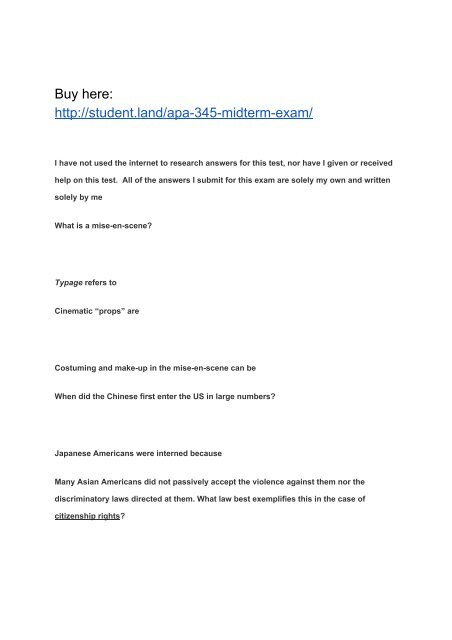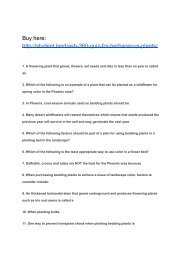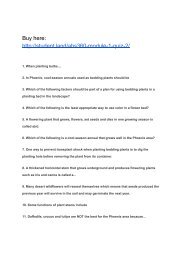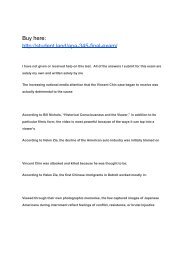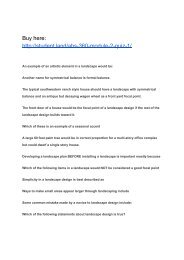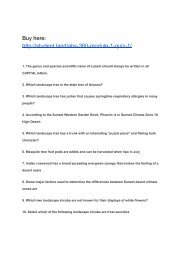APA 345 Midterm Exam
APA 345 Midterm Exam
APA 345 Midterm Exam
You also want an ePaper? Increase the reach of your titles
YUMPU automatically turns print PDFs into web optimized ePapers that Google loves.
Buy here:<br />
http://student.land/apa-<strong>345</strong>-midterm-exam/<br />
I have not used the internet to research answers for this test, nor have I given or received<br />
help on this test. All of the answers I submit for this exam are solely my own and written<br />
solely by me<br />
What is a mise-en-scene?<br />
Typage refers to<br />
Cinematic “props” are<br />
Costuming and make-up in the mise-en-scene can be<br />
When did the Chinese first enter the US in large numbers?<br />
Japanese Americans were interned because<br />
Many Asian Americans did not passively accept the violence against them nor the<br />
discriminatory laws directed at them. What law best exemplifies this in the case of<br />
citizenship rights?
Other Asian American experiences were just as bad as Japanese Americans during WW II<br />
How many waves of Southeast Asian refugee migrations were there?<br />
The Salvador Roldan case prevented ___<br />
What was the reason for the increase of Asian immigrants after 1965?<br />
The Japanese, Filipinos, and Asian Indians arrived around the same time as the Chinese<br />
in the US. True or False?<br />
According to Stam and Shohat’s “The Imperial Imaginary,” what is the one powerful tool<br />
that the cinema has which the novel and print does not have to give the viewer a sense of<br />
power and narcissism (eg., egocentricity)?<br />
In the film discussion of Wild Geese (1978), Shohat and Stam (“Imperial Imaginary”)<br />
describe it as emblematic of the late imperialist film in which imperialism is on its decline.<br />
What of the following is not part of Shohat and Stam’s (“Imperial Imaginary”) description<br />
of key narratives in the late imperialist film?<br />
In Stam and Shohat’s essay, “The Imperial Imaginary,” one “master trope” of<br />
Euroamerican cinema is that of nationhood. How does cinema give the sense of<br />
nationhood and national belonging?<br />
According to Stam and Shohat (“Imperial Imaginary”), how did the Gulf war narrative (in<br />
the US networks’ coverage of the first Gulf war) empower the US viewer to be righteous<br />
and all-seeing?
In the film Bitter Tea, Gina Marchetti (“Threat of Captivity”) suggests that Megan’s dream<br />
at Yen’s palace symbolizes<br />
According to Gina Marchetti’s essay “The Threat of Captivity,” from the beginning of the<br />
film, Bitter Tea recalls earlier tropes and narratives within American history. Which is it?<br />
According to Gina Marchetti (“Threat of Captivity”) and many film theorists, Josef von<br />
Sternberg’s films (Shanghai Express) are considered “exotic melodramas” because of his<br />
cinematic techniques. Why?<br />
According to Gina Marchetti’s essay “The Threat of Captivity,” in the Shanghai Express<br />
why is the Eurasian character Chang such a threat?<br />
According to Christina Klein (“Family Ties as Obligation”) what was the political agenda<br />
of the Christian Children’s Fund’s of Asian adoption?<br />
According to Christina Klein (“Family Ties as Obligation”), America’s fear of “Momism”<br />
during World War II changed over to the fear of _____ during post World War II. Fill in the<br />
blank.<br />
According to Christina Klein (“Family Ties as Obligation”), South Pacific created by Oscar<br />
Hammerstein was envisioned as an antiracist story, true or false?<br />
Christina Klein argues that during post World War II era, American middlebrow<br />
intellectuals and writers believed that the United States’ lack of obligation to Asia was the<br />
result of ______
In the film Sayonara, the double-suicide of Kelly and Katsumi would seem to provide<br />
social commentary about racism and classism. But according to Gina Marchetti, the result<br />
of the double-suicide in the rest of the film really shows what?<br />
In Marchetti’s “Tragic and Transcendent Love,” the film The Crimson Kimono uses _____<br />
difference as a way to avoid talking about _____ difference. Fill in the blanks<br />
According to Marchetti (“Tragic and Transcendent Love”), even while Sayonara envisions<br />
racial acceptance of Japanese and Asians, the representations of Hana Ogi and Katsumi<br />
(as Japanese women) are<br />
According to Gina Marchetti’s (“Tragic and Transcendent Love”) reading of Sayonara, any<br />
ideological critique of the military and the Korean War becomes relegated to Lloyd<br />
Gruver’s ______ (fill in the blank).<br />
According to William Wei, some Asian and Pacific Islanders are not as well recorded<br />
within <strong>APA</strong> history. Who are considered the “Forgotten Asian Americans?”<br />
During the early period of the Asian American Movement, artists and filmmakers believed<br />
that<br />
According to William Wei’s history of Asian American Activism in art and history, one of<br />
the first major exhibits showcased by The New York Chinatown History Project was story<br />
about<br />
In Stephen Gong’s “A History of Progress,” about the Asian American media arts<br />
movement, what is the difference between media/television and the media arts?
Since the 1990s, the most successful and probably well-known Asian American media<br />
arts center is:


